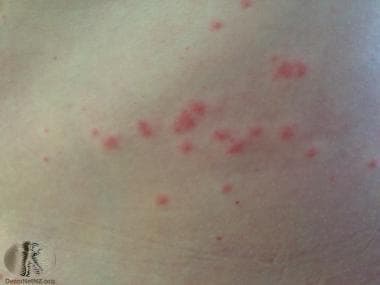Background
Seabather's eruption was first described in 1949 as a pruritic papular eruption occurring in bathers off the eastern coast of Florida. Seabather's eruption is a highly pruritic, papular eruption that occurs underneath the swimsuit after extended exposure to seawater. Seabather's eruption results from a hypersensitivity to the larval form of the thimble jellyfish, Linuche unguiculata. [1, 2] Cases have been reported in the Philippines and have been attributed to Linuche aquila and, rarely, Edwardsiella lineata. [3] Most cases occur from March to August, but the incidence peaks in May and June. See the image below.
 Seabather’s eruption. Courtesy of DermNet New Zealand (https://www.dermnetnz.org/assets/Uploads/arthropods/sea-bathers.jpg).
Seabather’s eruption. Courtesy of DermNet New Zealand (https://www.dermnetnz.org/assets/Uploads/arthropods/sea-bathers.jpg).
See Deadly Sea Envenomations, a Critical Images slideshow, to help make an accurate diagnosis.
See also the Medscape article Cutaneous Manifestations Following Exposures to Marine Life.
Pathophysiology
Seabather's eruption is a cutaneous hypersensitivity reaction to contact with the larval form (planulae) of the thimble jellyfish, L unguiculata. The eruption typically occurs underneath the bathing garments, which are believed to trap the jellyfish larvae against the skin. Whether the discharge of venom by the trapped larvae plays an important role in the pathogenesis of the eruption remains uncertain. Factors that promote the discharge of venom by the larvae include wearing of bathing suits for prolonged periods following swimming, exposure to fresh water through showering, and mechanical stimulation.
Etiology
Seabather's eruption is caused by exposure to the larval form (planulae) of the thimble jellyfish, L unguiculata. The seasonal variation in the concentrations of thimble jellyfish larvae in endemic areas lead to the increased incidence of seabather's eruption from May through August, with a peak in May and June.
Freudenthal and Joseph [4] reported the larvae of the sea anemone Edwardsiella lineata as the cause of an outbreak of seabather's eruption on Long Island, New York. This organism also has nematocysts. Various species of Cnidaria larvae in other waters can likely produce similar eruptions.
Epidemiology
Frequency
United States
The incidence of seabather's eruption is seasonal; the highest incidence occurs from May through August. This coincides with the warm gulf streams running along the Atlantic coastline of Florida and the corresponding spawn of thimble jellyfish larvae, which results in the high seasonal concentration of Linuche planulae. In 1997, Kumar et al [5] reported the occurrence of seabather's eruption in Palm Beach saltwater swimmers in May to be 16%.
International
Seabather's eruption has been reported in Mexico and the Caribbean and along the coast of Brazil. [6, 7, 8] Reports have occurred in the Philippines. [3] The true prevalence of seabather's eruption along other international coastlines remains unknown.
Race
Seabather's eruption occurs independent of race.
Sex
Seabather's eruption has been noted with equal frequency in both sexes.
Age
No correlation between age and risk for developing seabather's eruption has been noted. The severity of symptoms, particularly the frequency of fever, is greater in children than in adults.
Prognosis
Cutaneous eruptions clear in 2 weeks, with or without therapy. No deaths have been attributed to exposure to thimble jellyfish larvae.
Patient Education
Educate patients about thimble jellyfish larvae during peak seasons in affected areas and the preventative role of showering with the bathing suit off following exposure to the seawater.
For patient education materials, see Jellyfish Stings and Stingray Injury.
-
Seabather’s eruption. Courtesy of DermNet New Zealand (https://www.dermnetnz.org/assets/Uploads/arthropods/sea-bathers.jpg).

